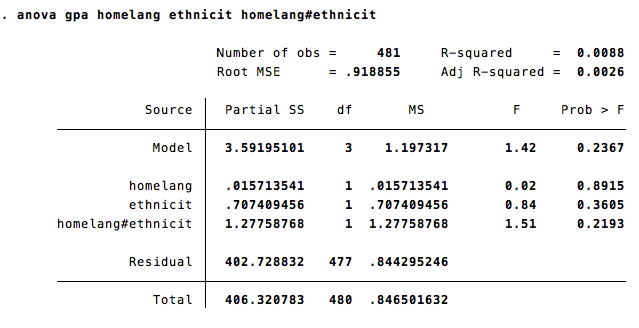The ANOVA Family
The ANOVA comes in two major varieties: those that are within-subjects and those that are between-subjects. Once there is more than one factor, you can also have mixed measures ANOVAs (with between- and within-subject aspects). However, regardless of which type of ANOVA you decide to run, the basic command is the same first word; anova
It is worth noting however, that if you are running a one-way ANOVA (testing one variable on one dimension, it is probably easier to use the oneway command (see here for those instructions).
If your ANOVA is more complicated than a single categorical variable however, anova is the way to go. The basic syntax is simply anova [dependent variable] [independent variables] [indep]#[indep] In practice that looks like anova gpa homelang ethnicit homelang#ethnicit which would run a 2X2 factorial ANOVA looking at the effects of ethnicity, language spoken at home, and the ethnicity*language interaction as predictive of a person's GPA. The output would look as follows:

While this example is only a 2X2, the logic can expand infinitely to accommodate extremely complicated, six dimensional designs with three and four and five-way interaction effects. In this case, the command would be the same, with the name of the dependent variable followed by the names of the independent variables and the interactions that you desire to explore.
Additional ANOVA Topics
- Running a Tukey-HSD test (and a Tukey-Kramer test and a Fisher-Hayter test) after an ANOVA
- Graphing cell means
- Example datasets from Stata
- Sequential versus partial sums of squares
- Repeated measure designs
- Mixed-measure designs
- Nested designs
- Running an ANCOVA
- The ANOVA command and regression
- More complex post-hocs
- Residuals and other fun things
- Back